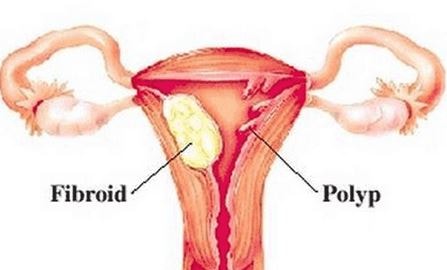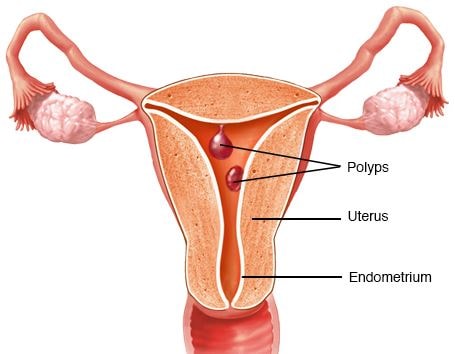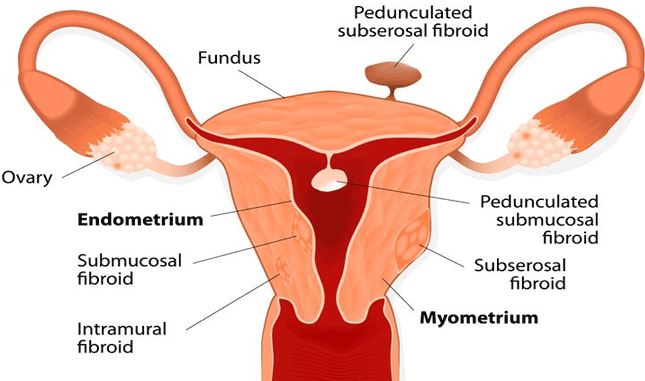Polyps in Uterus
What are Polyps?
Polyps are abnormal tissue growth which may develop in any organ that has a good blood supply. One of the most common area where they occur is the uterus and this has been a common condition for women [1, 2].
What is Polyps in Uterus
The uterus is primarily made up of muscle fibers but has an inner lining made up of endometrial tissue. This lining grows and shrinks during different stages of the menstrual cycle. If there is no fertilized egg attached to the lining, it will shed off as the menstrual period. The lining will start to grow again at the beginning of the next cycle due to the estrogen hormone. Polyps are areas in the uterus where there is an increased growth of the endometrial lining [1, 2].

The polyps of uterus would fan out as they grow but maintain their attachment to the uterus through a small stalk. Their sizes ranges from a few millimeters to several centimeters in diameter. Some are not bigger than a sesame seed while others may be as large as a golf ball. They usually just grow inside the uterus but there are instances where they may develop through the opening of the cervix. Uterine polyp growth is most common in women who are in their menopausal age but younger women may develop these growth as well. [2, 3]
ICD10 Code
N84.0 is the 2016 ICD-10-CM code that is used in this diagnosis [4].
Causes
The exact cause of polyp growth is still unknown but estrogen hormone levels have been thought to play an important factor. Estrogen has a major role in the thickening of the endometrium so it has been linked to the growth of uterine polyps [2, 3, 5].
Risk Factors
Women who are aged between 40- 50 years old have a higher risk of developing uterine polyps. Aside from age, other risk factors include being overweight and obese, high blood pressure and taking the anti-neoplastic drug, Tamoxifen [2, 3, 5].
Signs & symptoms
The most common symptom in women who have uterine polyps is having an irregular menstruation period. This symptom is present in around 50% of the affected population. Their menstrual cycles vary in length and the heaviness of the menstrual period also differs [2, 3, 5].
Other symptoms that may be experienced include bleeding in-between the cycles, vaginal bleeding after the menopause and infertility. However, there are others who do not present with any symptoms [2, 3, 5].
Diagnosis
Health history and physical examination
For women who are in the reproductive age, the focus of the medical history is getting more information about the usual menstruation cycle. Any changes with the cycle may indicate the presence of a uterine polyp. On the other hand, those who are in menopause should watch out for any degree of bleeding after the last menstrual cycle. The presence of other symptoms will be known with the aid of a physical examination [2, 5].
Additional tests
Getting a visualization of the polyp is necessary to identify the treatment that is necessary. These tests will aid the physician to see the uterine polyp [2, 5].
Transvaginal ultrasound
In this procedure, a small device that emits sound waves is inserted into the vagina. These waves will be able to show the inside of the uterus along with the polyps that is inside [5].
Hysteroscopy
This method is used not only in diagnosing but in the treatment of the polyp as well. A long, thin tube will be inserted into the vagina and the cervix. This instrument has a lighted telescope and will allow the physician to see the inside of the uterus [5].
Endometrial curettage
This procedure is performed inside the operating room using a long metal instrument that has a loop at the end. This tool will be able to obtain to scrape the polyp or the endometrial lining. The tissue sample will be sent to the laboratory for analysis to identify if any cancer cells are present in the submitted tissue [5].
Treatment of Polyps in Uterus
The treatment that is required depends on the size of the uterine polyp. Small polyps that do not produce any symptom need not to be removed but those that cause bleeding should undergo treatment. The polyps of a pregnant woman should be removed because they can cause problems such as a miscarriage. There are several methods that can be used to treat uterine polyps [1, 2, 3, 5]:
Medications
Drugs that regulate a woman’s hormone balance may be used to treat the problem temporarily. These drugs will help to relieve the symptoms but they will return once the medications are stopped [2, 3, 5].
Hysteroscopy and curettage
These diagnostic procedures allow the physician to view the inside of the uterus and remove the uterine polyp. The polyps will be sent to the laboratory for a biopsy to identify if they are benign or malignant [2, 3, 5].
Hysterectomy
If the polyps that have been removed in a curettage contain cancerous cells, there may be a need to remove the entire uterus to prevent it from recurring. This procedure is called hysterectomy [2, 5].
Pictures


References
- Healthline Medical. (2015). Polyps. Retrieved from Healthline: http://www.healthline.com/health/polyps#Overview1
- Hill, A. (2011, June 21). Endometrial Polyps. Retrieved from ObGyn.net: http://www.obgyn.net/laparoscopy/endometrial-polyps
- Mayo Clinic. (2015, August 29). Uterine polyps. Retrieved from Mayo Clinic: http://www.mayoclinic.org/diseases-conditions/uterine-polyps/basics/risk-factors/con-20027472
- ICD10 Data. (2015). Polyp of corpus uteri. Retrieved from ICD10 Data: http://www.icd10data.com/ICD10CM/Codes/N00-N99/N80-N98/N84-/N84.0
- Cleveland Clinic. (2014). Uterine Polyps. Retrieved from Cleveland Clinic: https://my.clevelandclinic.org/health/diseases_conditions/hic-uterine-polyps
